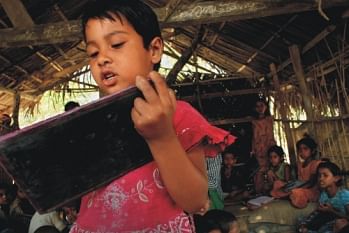First principles

How far is her education adequate? Photo: Azizur Rahim peu/ Drik News
THE quality and relevance of primary education, along with the rates of enrollment, dropout, completion and progression, continue to be ever-growing concerns, but without any redress since the overall efforts, of late, have been derailed of the right track of fulfilling the fundamental requirements and the development goals and targets.
In fact, there is a wide gap between constitutional obligations, and the policies and real practices, including lack of adherence to universal child-friendly pedagogic treatments and disparities of all kinds in education delivery.
Moreover, dual control of primary education (PE), disparity in teachers' profiles, absence of professional management capacities in the central organisations, outsourcing of routine functions etc., are also accountable for these. Outsourcing is de-institutionalising whatever institutionalisations took place since independence.
All this has resulted in Bangladesh's failure to promote a uniform system of education, thereby creating a knowledge divide among the citizens. Whereas, education, among the myriad of activities involved in human development, is the basic element that provides the foundation for developing and managing human resources effectively.
Here, though the curriculum is the prime mover of an education system, especially at the primary level, teachers are the providers of the basic foundation for subsequent stages of education, since they are instrumental in transmitting the curricular objectives to the learners.
So, teachers must have thorough insight into the subjects, and interpretational capacities along with pedagogical knowledge and skills for dealing with children of unknown potential. Thus, a teacher's profile is the most essential prerequisite for effective education.
Again, as PE is dependent upon the quality of secondary and higher education, its status in our overall system, in terms of structure, curricula and courses, delivery modes, institutional organisation, etc., is of critical importance along with the ground realities, including the disabling factors.
For example, grouping of SE into humanities, social science, science and business management from grade nine onwards, mainly as preparation for higher education, the highest level of comprehensive education is grade eight, which is far behind the contemporary basic needs of a moderately decent social life and the vital needs of teaching in primary schools.
A primary school teacher, irrespective of the subjects s/he studied, is required to teach all the eleven PE subjects upto grade 8, even if the subjects are not studied in grade 9 and above.
Dynamic knowledge proliferation has made PE subjects much more comprehensive and demanding, and can't be taught without thorough insight into the subjects. Because of the lack of the required minimum number of teachers (5-7) and rooms (5-7) per school, 95% of schools run two sessions daily by the same teachers, i.e. grades 1 and 2 in the morning for 2.5 hours and grades 3 to 5 in the afternoon for 3.5 hours, excluding leisure time.
Even this impoverished system is further undermined and complicated, with about 5,000 secondary schools with PE section or grade(s), whose primary children are denied the PE specific pedagogic treatments, while indirectly allowing them the benefits of enjoying universal "subject-based curricular" (SBC) approaches of teaching/learning under better facilities, avoiding redundant experimentation with "competency-based curriculum" (CBC), multiple ways of teaching-learning (MWTL), concentrated language encounter (CLE) etc., in primary schools.
That means, maintaining systemic double standards, disparities, dual control etc., resulting in lack of ownership, belongingness and accountability.
The situation in most primary schools is further worsened because of the wide gap between apparent and real annual school working days. Out of the official 200 working days (excluding 127 days of vacation/holidays, and 38 days for examinations), the effective working days are only about 100. About 137 man days are wasted, lost or made ineffective, because of involving teachers in many unavoidable, unnecessary and non-PE functions. For example, salary/subvention collection (36-48 days), model test examination at upazila HQs (4 days), sub-cluster training (6 days), MEENA program (3 days), monthly coordination meeting (12 days), casual leave (60-80 days), other training, etc., plus work like VGF distribution, and maternity leave as appropriate, cause unavailability of teachers for taking classes.
Moreover, primary schools, in spite of gross impoverishment, have been subjected to the highly demanding CBC replacing SBC over the last 22 years of preparation (since 1986) and implementation (since 1992), along with simultaneous experimentation with MWTL, CLE, etc., at the cost of our national education foundation, though none of these are considered essential for the students in secondary schools, English medium schools, kindergartens and madrasas; or for secondary/higher levels.
Teacher education is yet to be CBC-oriented. If SBC serves the purpose of PE in secondary schools and elsewhere, then why should primary school teachers be overburdened with the non-affordable CBC?
All the past and present successful citizens of Bangladesh, like the world over, have been the products of the time-tested SBC, which is still followed by the developed and developing countries, but with better facilities.
These, combined with systemic impoverishment, disparities and diversities in institutional organisations, teacher provisions, instructional strategies and processes, management, etc., have given rise to an education divide, which is multiplying alarmingly, mainly to the disadvantage of those in rural and remote areas and urban under-privileged groups.
Privileged children are blessed with many undue options even for PE distorting tier-specific curriculum delivery. And this is why our PE is continuously falling apart and/or failing even to streamline and consolidate the very basics, i.e. "oracy," "numeracy" and "operacy;" which is mainly because of the impoverished institutional organisation with inadequately prepared teachers and poor facilities.
Against the overall backdrop, all the systemic fundamental weaknesses of our PE deserve urgent priority action, leading to a uniform system under single control.
And the imperative, particularly for the political leadership, is to address the following:
- The shortage of staff and physical facilities
- Disparities in curricular approach and instructional processes;
- Incongruity between pupils' and teachers' training curriculum;
- Inadequate daily contact hours and effective annual working days;
- Realistic reforms in policies for attracting and retaining quality teachers, and
- Disparity in staff profile; besides a provision for ensuring teachers' combined content knowledge per school as per curricular demand in terms of subjects studied in SSC/HSC through adjustments in placements.
And since the fundamental weaknesses and the measures required for ensuring the essential minimum are known, all out efforts (recurrent and development) should be concentrated to these.

 For all latest news, follow The Daily Star's Google News channel.
For all latest news, follow The Daily Star's Google News channel. 



Comments